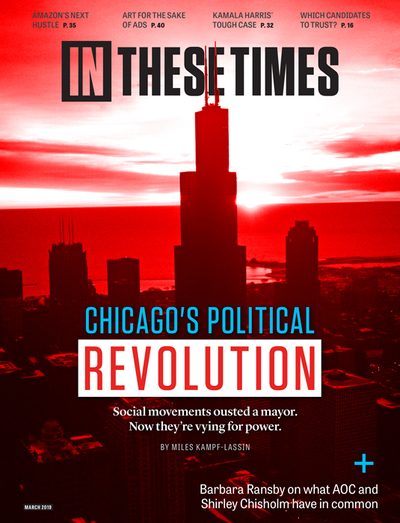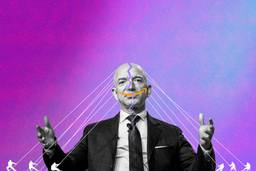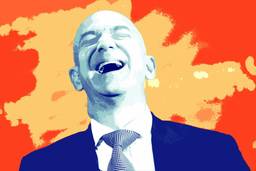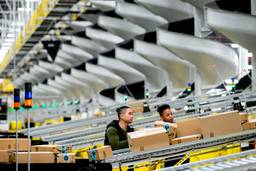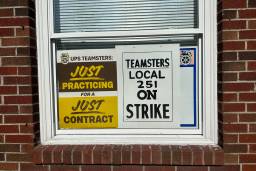New York Isn’t the Only City Waging a Fight Against Amazon
The corporate giant is still milking Nashville and other runners-up for further subsidies
David Dayen
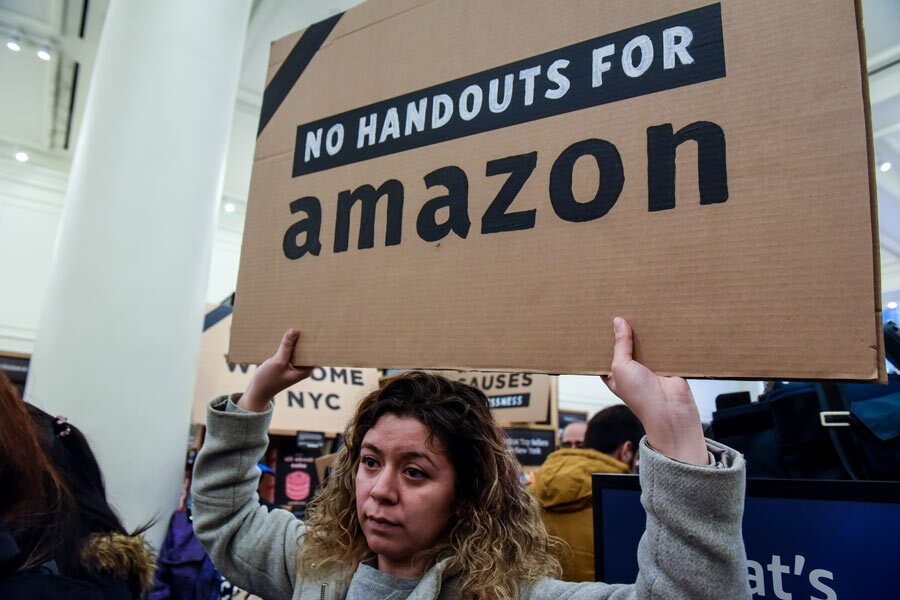
After this story went to press in the March issue of In These Times, Amazon backed out of its commitment to locate one of its two “HQ2” headquarters in New York City, citing opposition from local lawmakers and residents. The story has been updated to reflect.
Nashville, Tenn. — County employee Richard Tippit approached the podium at a January Metro Council meeting. Behind him, workers from local public-sector unions held aloft a posterboard stamped “PAST DUE.” Tippit began, “We’re here tonight to deliver you an invoice for services performed by the employees of Nashville Metro government.”
He and his fellow workers had come to collect $38 million in promised cost-of-living increases for 9,300 public employees that the city had reneged on. “You paid every other bill — you even added more bills,” Tippit said, “but you didn’t pay one of the most important.”
“More bills” referred to a sore point: $15 million in subsidies that Amazon extracted from the city in November 2018 for a new logistics facility. Amazon had effectively jumped the line for public dollars ahead of Nashville’s city workers.
Amazon’s proposed 5,000-employee “Operations Center of Excellence,” which received an additional $87 million in state subsidies, was announced the same day as Amazon’s new “HQ2” headquarters in New York City and northern Virginia. Nashville had been one of 20 finalists for HQ2, the subject of an unusual public auction process.
Though eclipsed by the HQ2 announcement, the Nashville news signaled that Amazon’s secretive public auction, the HQ2 sweepstakes, is not over. Through voluminous data collection and skillful exploitation of short-term political dynamics, Amazon has turned the normally perfunctory process of choosing a new office location into a lesson in how to raid municipal treasuries. Now, it’s hitting up the HQ2 also-rans for more public dollars to build out its empire. Even though the company has said it will not seek to relocate the New York HQ2 facility after withdrawing its offer on February 14, it could still use the cancellation as bait by moving employees intended for HQ2 to other cities.
In 2018, as the HQ2 derby raged, Amazon quietly collected $58.1 million from cities that bid for HQ2. That doesn’t include the $102 million for the logistics center in Nashville or the roughly $1.8 billion promised for the headquarters in Virginia. All told, in 2018, Amazon raked in nearly $2 billion from these deals. Four of the 20 finalists — northern Virginia, Nashville, Boston and Raleigh, N. C. — have received, in exchange for subsidies, an Amazon facility in or around their cities. More cities can expect to receive consolation prizes like Nashville’s, if they pony up.
The HQ2 race was more than a PR stunt. “Amazon has a fantastic data set of what communities are willing to provide for the project, the process of obtaining these incentives, and risk associated with them,” says Nathan Jensen, a professor of government at the University of Texas at Austin. “Amazon simply knows how high governments will jump.”
HQ2 kicked off in September 2017 as a cross between an expansion project and a reality game show. Amazon announced it would solicit bids across North America for a second headquarters, which would house 50,000 well-paid employees and contribute $5 billion in local investment.
It’s not like Amazon needed to pass the hat for a new office. Amazon is the world’s most highly valued company. It captures roughly half of all e-commerce sales and earned $56.6 billion in the third quarter of 2018. As more Americans use the internet for shopping, brick-and-mortar retailers have felt the pinch. Brands like Toys “R” Us, Gymboree, Brookstone and Nine West have gone bankrupt, and retailers like Sears, Ann Taylor and The Gap have shuttered hundreds of stores, leaving empty husks in malls across the nation.
Local governments, most of which are reliant on property taxes, have paid the price for this retail apocalypse. That hasn’t stopped cities from cozying up to Amazon, the destroyer of their tax base. In the United States, Canada and Mexico, 238 cities applied for HQ2.
A year and a half later, we still don’t know all their names. Amazon only released the number of bids, not where they came from. Practically everything the House of Bezos does is secret. “It’s clear that Amazon had a lot of requirements to keep things confidential,” says Paxtyn Merten, who worked for pro-transparency organization MuckRock on a project to collect every city’s HQ2 bid. At last count, MuckRock has only acquired 82 of the 238 bids, and many of those are redacted.
Some of the more outlandish offers — a 21-foot saguaro cactus gifted by Tucson, Ariz., and a proposed renaming of 345 acres of Stonecrest, Ga., as “Amazon, Georgia” — have been made public. But like WWE, this game was rigged.
The eventual winners of the HQ2 sweepstakes, New York City and northern Virginia, were almost certainly Bezos’ choices all along. Amazon already had large offices there, as New York and D.C. contain the tech-savvy workforces, transportation hubs, and educational facilities the company needs. CEO Jeff Bezos owns a home in New York and recently bought a giant mansion in D.C., along with the local newspaper. Amazon’s most aggressive pushes recently have been in entertainment (New York), advertising (New York), and government procurement (D.C.), including a lucrative cloud contract with the Pentagon (literally blocks from the new HQ location in Crystal City, Virginia).
In addition to PR, the ersatz competition served several purposes. It likely bid up the incentives from New York and Northern Virginia. Most important, it created a comprehensive database of North American city planning.
Amazon won’t just build headquarters over the next several years, but also logistics hubs, data farms, technology incubators, distribution centers and home offices for its spate of affiliated companies, from Audible to Twitch. Plus, it’s adding physical retail outlets nationwide. Thanks to HQ2, it knows available site locations for retail and commercial space in hundreds of cities, as well as what those cities are willing to fork over in subsidies.
The 20 finalists delivered even more granular information: race and ethnicity demographics, health and fitness opportunities, citywide K-12 performance, STEM degrees at nearby universities, zoning designations throughout the metro region, even the price of milk, bread and an avocado at Whole Foods (an Amazon subsidiary). New York’s response filled 253 pages.
All of that residential and consumer data is valuable to an e-sales company. “If I’m selling stuff, I now have information that my competitors do not have,” says Mark Funkhouser, the former mayor of Kansas City and current publisher of Governing magazine. “Where is the sales tax generated? The property tax? Where are the sewer lines?”
Some of the 20 finalists began receiving consolation prizes even before the HQ2 decision was announced. In May 2018, Amazon announced a regional headquarters for 2,000 machine learning and robotics employees in Boston. The company took home $30 million in incentives.
An HQ2 application from Raleigh that projected 63 percent population growth in the next 30 years may have got Amazon thinking. Last August, the city of Garner, a 32,000-resident commuter suburb of Raleigh, committed to a giant Amazon fulfillment center at a former ConAgra plant where a fatal explosion occurred in 2009. Amazon expects to provide 1,500 warehouse jobs at the site.
For its part, Garner is contributing $600,000, about 2 percent of its 2019 budget, to a $5.1 million project to improve a state road leading past the facility. “This is not a subsidy but an investment in public infrastructure,” says Joseph Stallings, economic development director for the city. North Carolina’s Department of Transportation will produce up to $4.5 million.
To fulfill its promises of two-day shipping, Amazon needs warehouse locations everywhere. So why did Garner have to pony up public money to rebuild a road for an Amazon warehouse?
Stallings implies that cities must offer subsidies to compete with other offers. “If everyone is playing with a corked bat and you’re not, you won’t get far.”
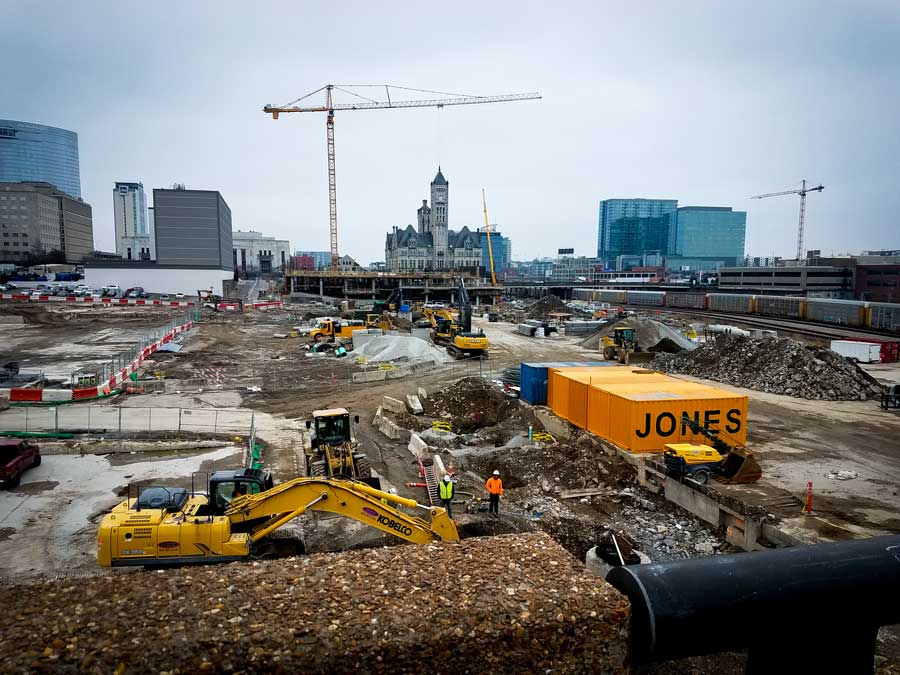
(The Nashville Yards complex was already under construction when Amazon agreed to rent space there— and collected $102 million in incentives for the privilege. Photo courtesy of David Dayen.)
It’s hard to even take in all of Nashville Yards. It sits on 16 acres bisected by a freight rail line, a few blocks from a neon-lit tourist trap of live music stages and barbecue joints. The site plan includes a luxury hotel, a 4,500-seat theater, a movie multiplex, a condo tower, restaurants, green space and 1.5 million square feet of high-rise offices. In November 2018, months after construction began, Nashville learned it would include Amazon offices, too.
According to Metro Council member Bob Mendes, the office tower Amazon will occupy was already in site plans before the company got involved. Presumably, the Nashville Yards developers weren’t planning a large office tower to leave it empty; they would have found a renter. Yet Amazon managed to extract $102 million for the privilege. Of that amount, $80 million comes in the form of cash grants: $500 per job for seven years from Nashville, and a $65 million grant from the state for capital expenditures. Tennessee is also providing $21.7 million in credits to offset business taxes. And if the company relocates employees intended for the New York City headquarters to Nashville, the per-job cash grants the city and state have bestowed would grow.
Nashville had plenty to offer before the first dollar of incentives. Its downtown has experienced explosive business growth. Several colleges, led by Vanderbilt University, could serve as a talent pipeline. But not only does Amazon jump into a turnkey office without paying any construction fees; it gets a logistics center in the most strategic setting for logistics in the country.
Three major interstate highways and two rail yards converge in Nashville, and 75 percent of the U.S. population is reachable within a two-hour flight. Logistics is close to half the economy in this part of the Southeast, known as “Freight Alley.” Over a dozen large logistics businesses call Nashville home; FedEx’s headquarters is in Memphis; and UPS sits four hours down the road in Atlanta. And we know Amazon is building a shipping service to compete with FedEx and UPS.
Given all these attractions, were cash grants for Amazon necessary? “That’s the $15 million question,” says Mendes. He adds that the city grants were on the low side relative to other recent economic development deals in Nashville, and probably weren’t the decisive factor for Amazon. But if that’s the case, “Why did you have to give them the money?” asks Mark Naccarato of SEIU Local 205, which represents city workers.
Because the city of Nashville released its HQ2 pitch, we can see similarities in the operations center grant. Nashville Yards was offered as a potential HQ2 location. The grant’s offer of $500 per job for seven years echoes the HQ2 proposal of $500 a job for 15 years. Nashville also offered a property tax cut, but Amazon’s renting: They won’t be paying property tax.
The $87 million in state grants to Amazon are nearly six times what Nashville is kicking in. But we know less about them and their origins. The Tennessee Department of Economic and Community Development decided to keep the state’s pitch for HQ2 secret for five years. Spokeswoman Jennifer McEachern told In These Times , “Publication of that material would hinder the state’s future ability to compete for economic development projects.” Such concealment renders impossible public scrutiny of what Tennessee asks of corporations in exchange for taxpayer dollars.
There’s no guarantee the Amazon jobs will go to city residents rather than commuters or national recruits. Where those workers will live, and how they will get to the office, is an acute problem for a city struggling with affordabilityissues. Traffic snarls the Nashville area on a daily basis, and a recent referendum to expand mass transit failed. Housing costs have spiraled, with one-quarter of renters paying over half their income in rent.
Despite runaway business growth, Nashville finds itself in a budget crisis. In the most recent assessment in 2017, Nashville’s city government decided to keep property tax revenue constant, even though property values had soared and population jumped. This created the lowest property tax rate in the city’s history, something Nashville touted in its pitch to Amazon. But it also created a massive shortfall, as Nashville suddenly couldn’t afford pay increases for city workers or to fill a $40 million hole in the education budget. The city backed out of the promised raises.
The Amazon project will do little to help. The property tax revenue won’t come from Amazon, and the project is set in a development district where a portion of sales taxes is earmarked to pay down debt on a downtown convention center.
At Nashville’s January 15 Metro Council meeting, city employees spoke about the sting of seeing their city slip cash to Amazon while workers got shafted. “If the money for Amazon can be found, the money to pay those who are the backbone of the city should be just as easily identifiable,” said Theresa Wagner, a middle school teacher. “It’s time to make our children at least as valuable as billionaire investors.”
But the council opted to defer a vote on a nonbinding resolution to halt any corporate incentive payments until city employees receive their cost-of-living increase. Meanwhile, the council advanced a participation agreement for Nashville Yards, kicking in an additional $15 million for infrastructure improvements, over the objections of some council members who saw it as an effective doubling of Amazon’s incentives.
Despite these defeats, activists have gotten the attention of the council and broadened economic development conversations to whether projects benefit the entire community. “Before, the thinking was that all jobs are good jobs,” says Michael Callahan-Kapoor, an organizer with Stand Up Nashville, an SEIU Local 205-backed labor-community coalition that has been critical of the deal. “But that economic model doesn’t work.”
The resistance to Amazon’s post-HQ2 bounty, not only in Nashville but in New York and D.C., suggests that the sweepstakes may have backfired. Grassroots protests, contentious city council meetings and even high-profile opposition from Rep. Alexandria Ocasio-Cortez led Amazon to cancel the New York facility. Amazon’s failure in New York offers a model to local organizers on how to limit or prevent corporate subsidies that don’t benefit the entire community.
Amazon did not respond to requests for comment for this story.
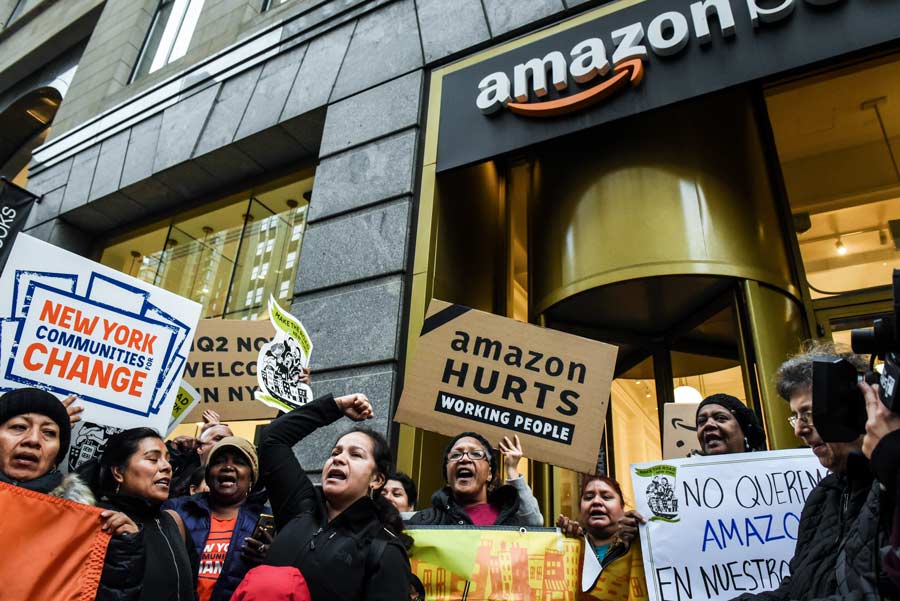
(Protesters with New York Communities for Change demonstrate in Manhattan against the billion-dollar subsidy package for Amazon’s New York headquarters Nov. 26, 2018. Photo by Stephanie Keith/Getty Images)
HQ2 alerted the public to the long-running economic development subsidy scam, which nets corporations some $45 billion to $90 billion a year from local governments. Nevertheless, Amazon will be reaping the benefits of the sweepstakes for years. In places like Nashville, those subsidies feel like a wealth transfer, with money pulled away from services for society’s most vulnerable and put into the hands of America’s biggest winners.
“To city leaders, economic development is justified because we will see returns on that investment,” says James Fraser. “But the people rewarded are not low-income people.”
Funkhouser, the former Kansas City mayor, thinks the only way to stop the bidding wars is to create a federal law prohibiting them. “It’s illegal for an American firm to accept a bribe in Brazil,” he says, referring to the Foreign Corrupt Practices Act. “But they can accept a bribe in the United States. They can accept $102 million. It is absolutely straight-up corrupt.”
